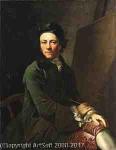Anton Graff
Anton Graff
Place: Winterthur
Born: 1736
Death: 1813
Biography:
Anton Graff was an eminent Swiss portrait artist. Among his famous subjects were Friedrich Schiller, Christoph Willibald Gluck, Heinrich von Kleist, Frederick the Great, Friederike Sophie Seyler, Johann Gottfried Herder, Gotthold Ephraim Lessing, Moses Mendelssohn and Christian Felix Weisse. His pupils included Emma Körner, Philipp Otto Runge and Karl Ludwig Kaaz.
Anton Graff was born as the seventh child of the craftsman Ulrich Graff and Barbara Graff née Koller at Untertorgasse 8 in Winterthur, Switzerland (the house does not exist anymore). In 1753 Graff started studying painting at the art school of Johann Ulrich Schellenberg in Winterthur. After three years he left Winterthur for Augsburg. There he worked with the etcher Johann Jakob Haid. However, only one year later he was forced to leave Augsburg. He was too successful. The members of the local painters guild feared his competition. With a letter of recommendation from Johann Jakob Haid, he moved to Ansbach where he found employment with the court painter Leonhard Schneider until 1759. Graff travelled frequently to Munich to study the paintings in the different collections. In 1759 he went back to Augsburg and later moved to Regensburg. In 1765 he went back to Winterthur and Zurich. It was there where he received an invitation from Christian Ludwig von Hagedorn, the newly appointed Director of the recently established Dresden Art Academy, to apply for a post at the Dresden Art Academy. Graff hesitated to do so. He thought he was not good enough to work for the princely court of Saxony. To give Hagedorn an impression of his talent he sent a self-portrait to Dresden. The self-portrait arrived on 16 January 1766, in Dresden. It was so well received that only one day later Hagedorn worked out Graff's employment contract. On 7 April 1766, Graff arrived in Dresden where he was appointed court painter and teacher for portrait painting at the Dresden Art Academy, a post he kept for life although he got better paid offers at other academies, among others in Berlin. In early 1788, the Prussian Minister Friedrich Anton von Heynitz made Graff the financially very attractive offer to work for the Prussian Academy of Arts in Berlin. On 7 May 1789, Graff informed Count Camillo Marcolini, general director of the Dresden Art Academy, about this. Marcolini reacted straight away. On 20 June 1789, Graff was appointed Professor for portrait painting at the Dresden Art Academy.
Graff made portraits of nearly 1,000 of his contemporaries and was the leading portrait painter in Germany in the late 18th and early 19th century. Graff was also the main portrait painter of German poets between the Enlightenment and the early Romantic periods. Many of them were also his friends, like Johann Wolfgang von Goethe whom he met in Dresden in 1768. Graff was the favourite portrait painter of the German, Russian, Polish and Baltic nobility. Among others he portrayed Stanislaw Kostka Potocki. His most important clients included Catherine the Great of Russia and Frederick the Great of Prussia. His portrait of Frederick the Great is regarded as his masterpiece. The painting is exhibited at Schloss Charlottenburg. Frederick the Great never posed for Graff. However, Graff got the authorization to watch the troops parade in 1781. This was the chance for Graff to study the physiognomy of the King and this was the base to paint the best known portrait of Frederick the Great.
Graff was also very popular with the landed gentry, diplomats, musicians and scholars. He portrayed many of them. While painting a portrait, Graff always focused the light on the person's face. In Graff's portraits it was always the face that got the attention and the light, except when the sitter was a lady. In that case he also focused on the lady's décolleté. Graff was a master of light and shadow. His role model in this context was Ján Kupecký whose works he studied in the collections of Ansbach. In comparison with the calmness of the ladies the gentlemen in his portraits often appear serious and reserved.
He also knew how to paint dresses and draperies of different materials and colours in a natural way. His role model in this field was the French court painter Hyacinthe Rigaud. In 1765/66 Graff portrayed Elisabeth Sulzer in a blue silk dress with silver laces and fur collar and borders.
In his early years, Graff did hardly ever paint any background details in his portraits. He usually kept the background monochrome. However, in his later years he also paid more attention to the background. Usually he painted the sitter in outdoor surroundings, as was the fashion at that time in England. The price for a portrait by Graff was calculated by size and details of the sitter's clothes. That it was not always easy for Graff to portrait the famous of the time shows the remark he made while painting Friedrich Schiller: "He cannot sit still." Graff was much in demand. He could live a comfortable life with his income.
More...
Wikipedia link: Click Here














